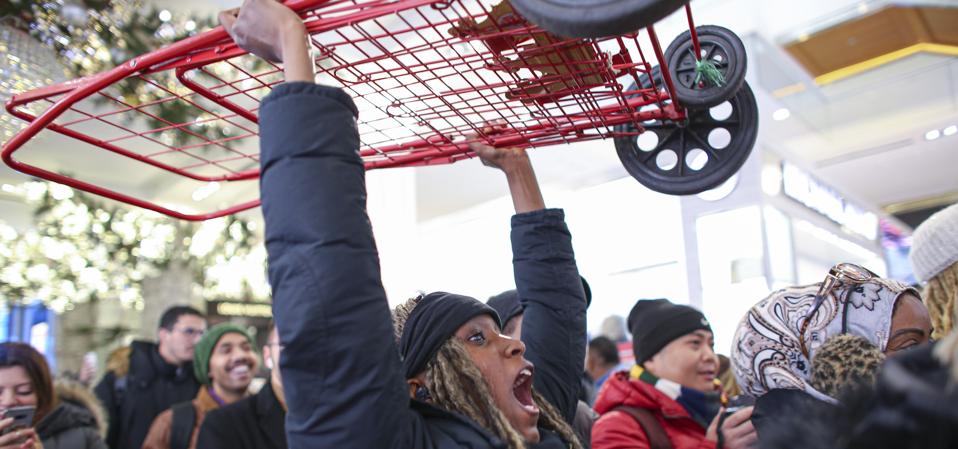Black Friday, the shopping frenzy that follows Thanksgiving, holds immense power over consumer behavior. This annual extravaganza, renowned for its irresistible discounts, turns even the most composed shoppers into impulsive buyers. This year, U.S. consumers are projected to splurge an average of $567 during Black Friday / Cyber Monday – a whopping 13% surge from last year!
But Black Friday isn’t just about shopping: it’s a captivating masterclass in the art of mass influence. Leaders can glean invaluable insights from this phenomenon to drive any change, even as momentous as motivating employees to return to the office.
Let’s face it, mandates to return to the office and extravagant perks haven’t quite hit the mark. The reality is that a full-time return to the office is unlikely, while working remotely on a permanent basis faces strong resistance from leadership. As organizations look to the future, a hybrid arrangement appears to be the most viable solution. With that in mind, here are three psychological factors that influence consumer behavior on Black Friday, which leaders can leverage to encourage people to return to the office…at least some of the time.
Scarcity: Make the Office a Valuable Resource
On Black Friday, retailers employ clever tactics like limited-edition items, exclusive deals or display the limited stock levels of products to create a thrilling sense of scarcity. This drives shoppers to take action quickly, fearing they might miss out. It’s called the scarcity principle: when something appears to be in short supply or hard to obtain, people assign it greater value and fear losing the opportunity to have it.
This powerful principle can also be used to persuade, rather than mandate, your employees to return to the office. For example, instead of indefinite return-to-office mandates, leaders can introduce a “limited window” for certain office “benefits”. These could include priority workspace reservations, exclusive in-person training sessions, or first access to team-building events.
The goal is to cultivate a feeling of healthy scarcity, enticing employees with the allure of valuable experiences they could potentially miss out on if they don’t spend some time in the office. It’s important to note that this approach is not about imposing mandates or penalties on those who prefer remote work. Rather, it’s about creating a positive incentive for employees, making the office a desirable and valuable resource worth experiencing.
Urgency: Harness the Power of Now
On Black Friday, shoppers are fueled by the adrenaline rush to act swiftly and make purchases before time runs out. Building a sense of urgency is crucial for retailers, achieved through strategies such as countdown timers, flash sales, or limited-time early bird discounts. This is known as the urgency principle: invoking a fear of time slipping away that compels customers to take immediate action.
Similarly, leaders can motivate employees to come to the office periodically by creating a sense of urgency. This can be done through time-bound opportunities exclusive to the office environment. For example, scheduling important strategic meetings, brainstorming sessions, or workshops in person and on specific dates. Additionally, hosting time-limited networking events or inviting expert guest speakers can also encourage employees to prioritize being in the office.
However, it’s important to balance this approach with empathy and flexibility, ensuring that employees who prefer or need to work remotely aren’t disadvantaged. The goal is not to induce panic or stress, but to encourage employees to seize opportunities that can enhance their growth and workplace relationships.
Social Proof: Inspire a Comeback
The shopping frenzy on Black Friday is partly fueled by the power of influence. Shoppers are captivated by the actions and reactions of others, drawn in by reviews, ratings, testimonials, recommendations, and good old-fashioned word-of-mouth. When uncertainty lingers in the air, people seek reassurance in the collective voice. This fascinating phenomenon, known as the social proof principle, not only shapes our shopping habits but can also be harnessed to entice your team back to the office.
For example, leaders can highlight the success stories and best practices of other teams (or organizations) that have office routines, and how they have benefited from them. They can also seek and share suggestions from employees on how they appreciate the level of collaboration or performance when working in the office. The power of social proof is that you don’t need everyone to buy in initially. Studies on mass behavior shift reveal that securing the unwavering belief of just 10% can ignite broader adoption of that belief within the community.
The return-to-office initiatives, much like the Black Friday phenomenon, require a discerning understanding of human behavior to be successful. Leveraging the principles of scarcity, urgency, and social proof can be instrumental in crafting a compelling narrative that encourages employees to return to the office, albeit on a hybrid basis. However, it’s crucial for leaders to remember that there’s no one-size-fits-all strategy. Each team is unique, with distinct dynamics, ways of working, and individual preferences. The key is to tailor these principles to suit your team’s unique needs, while ensuring an environment of inclusivity, empathy, and flexibility. After all, the most effective workplaces are those that value and respect their employees’ individual circumstances and choices.

